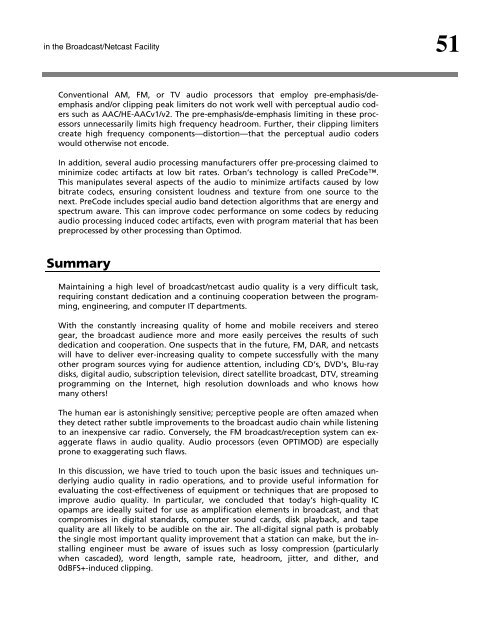Maintaining Audio Quality in the Broadcast Facility 2011 - Orban
Maintaining Audio Quality in the Broadcast Facility 2011 - Orban
Maintaining Audio Quality in the Broadcast Facility 2011 - Orban
Create successful ePaper yourself
Turn your PDF publications into a flip-book with our unique Google optimized e-Paper software.
<strong>in</strong> <strong>the</strong> <strong>Broadcast</strong>/Netcast <strong>Facility</strong> 51<br />
Conventional AM, FM, or TV audio processors that employ pre-emphasis/deemphasis<br />
and/or clipp<strong>in</strong>g peak limiters do not work well with perceptual audio coders<br />
such as AAC/HE-AACv1/v2. The pre-emphasis/de-emphasis limit<strong>in</strong>g <strong>in</strong> <strong>the</strong>se processors<br />
unnecessarily limits high frequency headroom. Fur<strong>the</strong>r, <strong>the</strong>ir clipp<strong>in</strong>g limiters<br />
create high frequency components—distortion—that <strong>the</strong> perceptual audio coders<br />
would o<strong>the</strong>rwise not encode.<br />
In addition, several audio process<strong>in</strong>g manufacturers offer pre-process<strong>in</strong>g claimed to<br />
m<strong>in</strong>imize codec artifacts at low bit rates. <strong>Orban</strong>’s technology is called PreCode.<br />
This manipulates several aspects of <strong>the</strong> audio to m<strong>in</strong>imize artifacts caused by low<br />
bitrate codecs, ensur<strong>in</strong>g consistent loudness and texture from one source to <strong>the</strong><br />
next. PreCode <strong>in</strong>cludes special audio band detection algorithms that are energy and<br />
spectrum aware. This can improve codec performance on some codecs by reduc<strong>in</strong>g<br />
audio process<strong>in</strong>g <strong>in</strong>duced codec artifacts, even with program material that has been<br />
preprocessed by o<strong>the</strong>r process<strong>in</strong>g than Optimod.<br />
Summary<br />
<strong>Ma<strong>in</strong>ta<strong>in</strong><strong>in</strong>g</strong> a high level of broadcast/netcast audio quality is a very difficult task,<br />
requir<strong>in</strong>g constant dedication and a cont<strong>in</strong>u<strong>in</strong>g cooperation between <strong>the</strong> programm<strong>in</strong>g,<br />
eng<strong>in</strong>eer<strong>in</strong>g, and computer IT departments.<br />
With <strong>the</strong> constantly <strong>in</strong>creas<strong>in</strong>g quality of home and mobile receivers and stereo<br />
gear, <strong>the</strong> broadcast audience more and more easily perceives <strong>the</strong> results of such<br />
dedication and cooperation. One suspects that <strong>in</strong> <strong>the</strong> future, FM, DAR, and netcasts<br />
will have to deliver ever-<strong>in</strong>creas<strong>in</strong>g quality to compete successfully with <strong>the</strong> many<br />
o<strong>the</strong>r program sources vy<strong>in</strong>g for audience attention, <strong>in</strong>clud<strong>in</strong>g CD’s, DVD’s, Blu-ray<br />
disks, digital audio, subscription television, direct satellite broadcast, DTV, stream<strong>in</strong>g<br />
programm<strong>in</strong>g on <strong>the</strong> Internet, high resolution downloads and who knows how<br />
many o<strong>the</strong>rs!<br />
The human ear is astonish<strong>in</strong>gly sensitive; perceptive people are often amazed when<br />
<strong>the</strong>y detect ra<strong>the</strong>r subtle improvements to <strong>the</strong> broadcast audio cha<strong>in</strong> while listen<strong>in</strong>g<br />
to an <strong>in</strong>expensive car radio. Conversely, <strong>the</strong> FM broadcast/reception system can exaggerate<br />
flaws <strong>in</strong> audio quality. <strong>Audio</strong> processors (even OPTIMOD) are especially<br />
prone to exaggerat<strong>in</strong>g such flaws.<br />
In this discussion, we have tried to touch upon <strong>the</strong> basic issues and techniques underly<strong>in</strong>g<br />
audio quality <strong>in</strong> radio operations, and to provide useful <strong>in</strong>formation for<br />
evaluat<strong>in</strong>g <strong>the</strong> cost-effectiveness of equipment or techniques that are proposed to<br />
improve audio quality. In particular, we concluded that today’s high-quality IC<br />
opamps are ideally suited for use as amplification elements <strong>in</strong> broadcast, and that<br />
compromises <strong>in</strong> digital standards, computer sound cards, disk playback, and tape<br />
quality are all likely to be audible on <strong>the</strong> air. The all-digital signal path is probably<br />
<strong>the</strong> s<strong>in</strong>gle most important quality improvement that a station can make, but <strong>the</strong> <strong>in</strong>stall<strong>in</strong>g<br />
eng<strong>in</strong>eer must be aware of issues such as lossy compression (particularly<br />
when cascaded), word length, sample rate, headroom, jitter, and di<strong>the</strong>r, and<br />
0dBFS+-<strong>in</strong>duced clipp<strong>in</strong>g.



![[PDF] Using the ITU BS.1770-2 and CBS Loudness Meters ... - Orban](https://img.yumpu.com/50629372/1/190x245/pdf-using-the-itu-bs1770-2-and-cbs-loudness-meters-orban.jpg?quality=85)






![[PDF] Optimod-FM Feature Comparison - Orban](https://img.yumpu.com/41741615/1/190x245/pdf-optimod-fm-feature-comparison-orban.jpg?quality=85)






